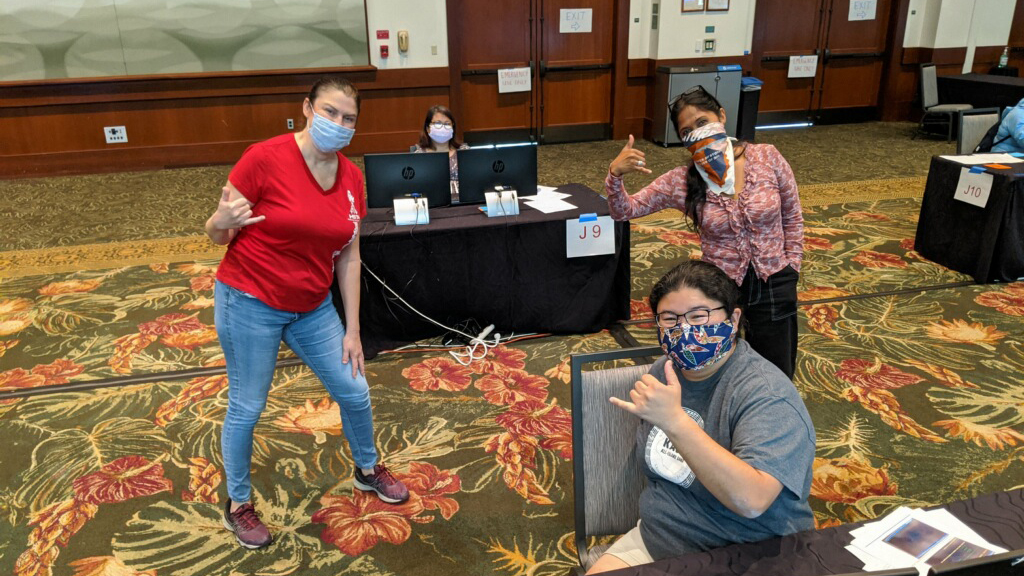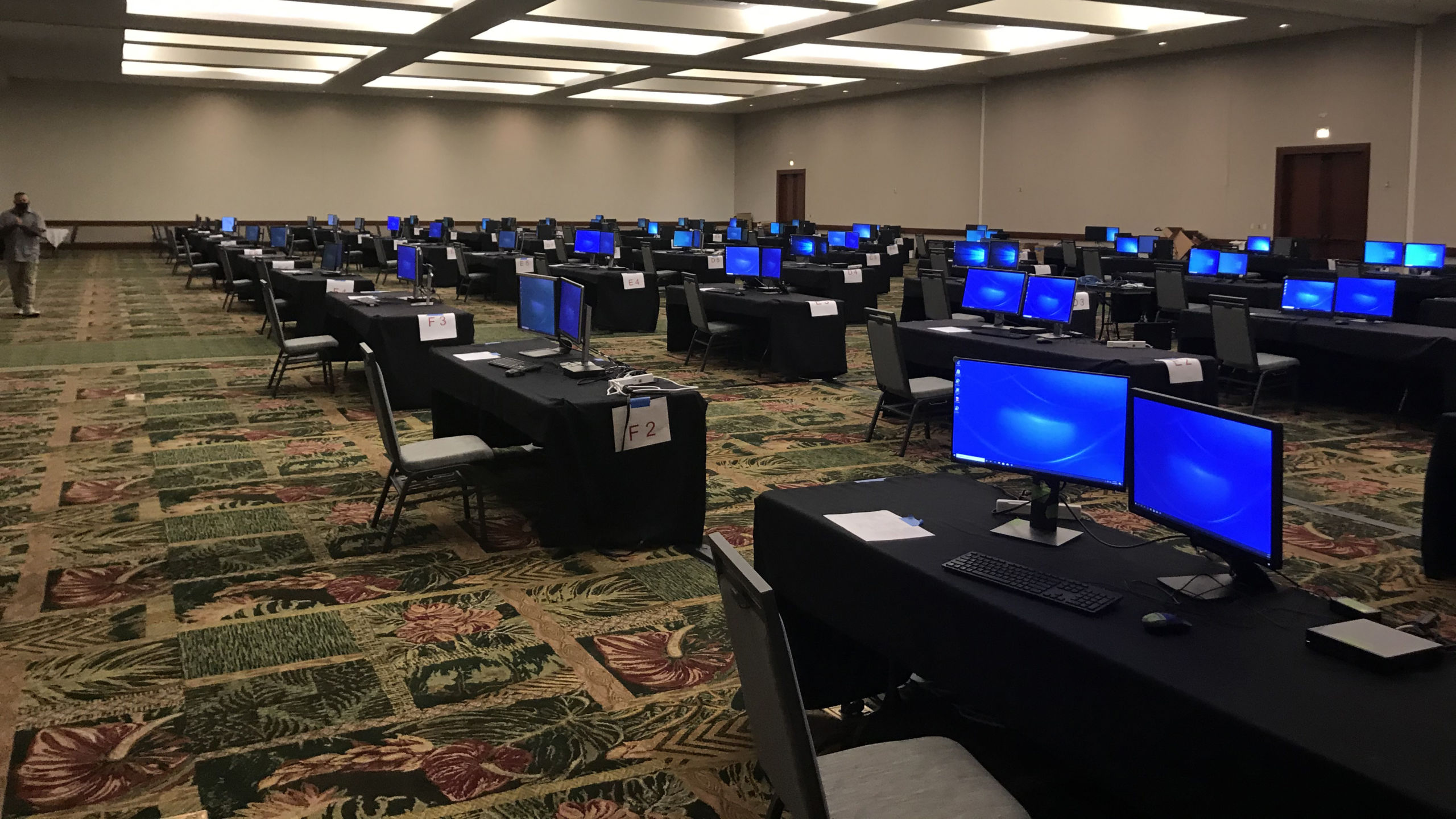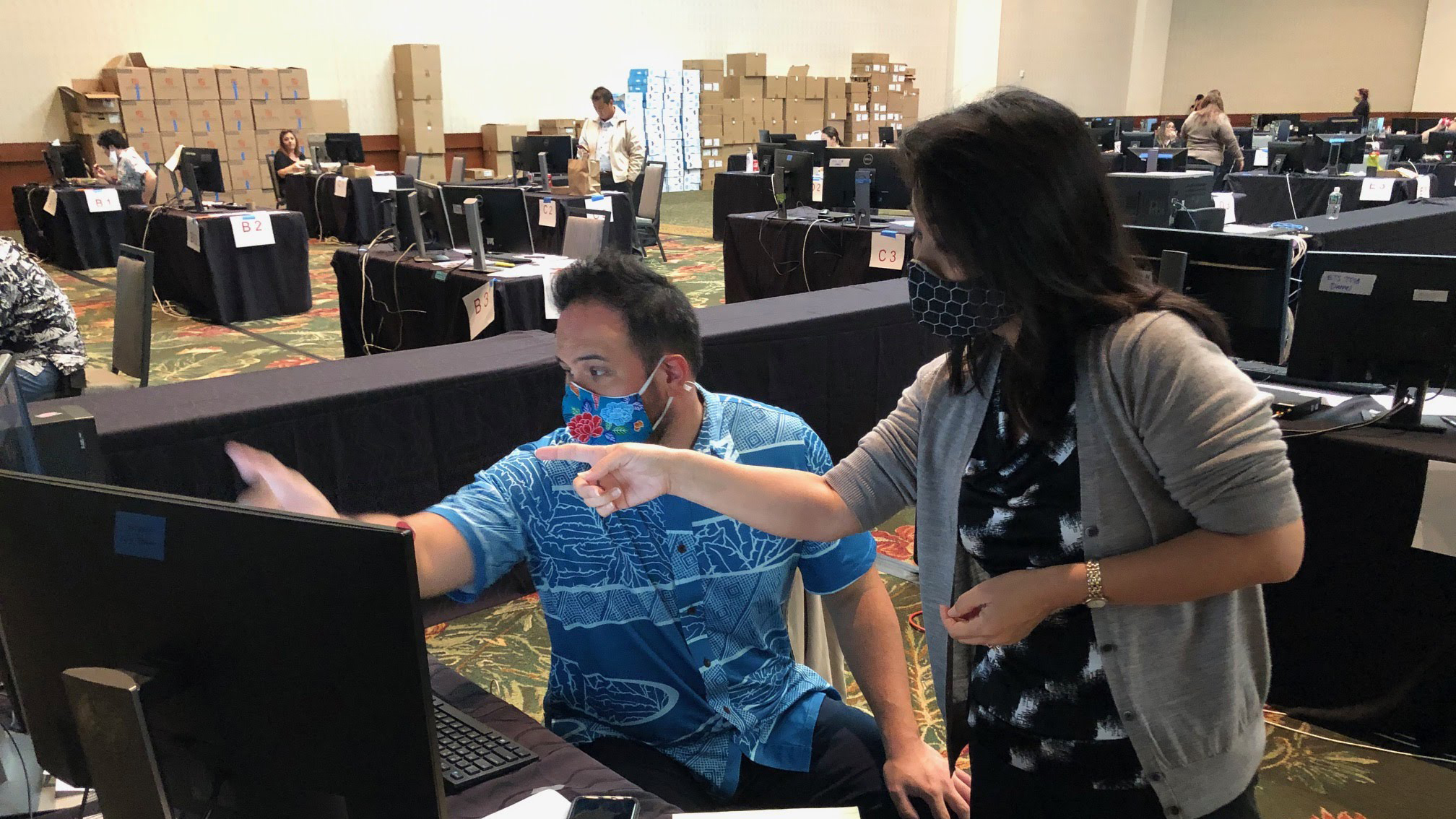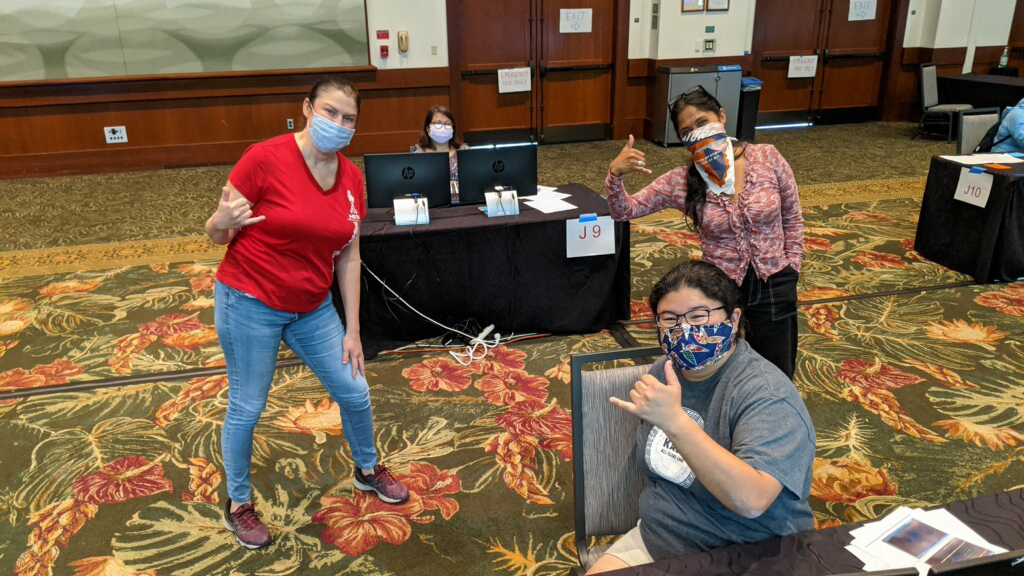
A handful of educators juggled their remote teaching commitments to join more than 100 other public-sector union member volunteers from Hawaii State Teachers Association, Hawaii Government Employees Association, and the University of Hawaii Professional Assembly who started working on the massive backlog of unemployment claims Thursday at the Hawaii Convention Center.
Campbell High physical science teacher Christine Russo, who went through about two hours of training Thursday, began working on jobless claims immediately after that.
“I know that there's a huge backlog in processing the unemployment claims and I wanted to be part of the solution to get families across the state their unemployment checks because I know that they're suffering right now,” said Russo. “My boyfriend has been furloughed and he’s the other breadwinner in the house, so it has that personal connection as well.”
Even though she spent much of the day at the temporary unemployment center office Thursday, Russo said, “I have been still conducting all my classes with them on and providing them with enrichment resources on my class website.
“Even though I'm here doing the unemployment claims, they said they’ll be flexible. I have online class twice a week with my students in addition to the resources I have provided them, so I’m going to break and do my online class outside for an hour, and then go back in and continue the unemployment processing,” she added.
Sherry Cassetta, an inclusion math teacher at Campbell, joined her colleague Russo for training and unemployment work Thursday.
“If I asked my students, 'What do you think guys think, should I do it or not?' They would turn around and say 'That would be pono,' because in our leadership class after school, we’re always talking about what’s right for them, what’s right for the community, what’s right for the school,” Cassetta said.
“I’m thankful that I have a co-teacher, and she’s willing to be flexible,” Cassetta said, which allows her to help out.
Cassetta said the volunteer work on top of coordinating remote learning for her Campbell math students is “complimenting what we’re teaching.”
“It’s tough, but it’s the role of just being a teacher,” she said. “Getting people the money they need to put food on the table, that’s what really matters right now. We’re here as an ohana, as a big team, as one Hawaii.”

Photo: Department of Labor and Industrial Relations
Educator says 'My students' parents and my friends and so many other people are really hurting'
Chiefess Kamakahelei Middle School band director Sarah Tochiki, who usually works on Kauai, is teaching remotely from Oahu, because she’s staying with her elderly parents, running errands and shopping for them during the pandemic.
Asked why she volunteered to help process jobless claims, Tochiki said, “My students’ parents and my friends and so many other people are really hurting because they can’t process the claims fast enough. I know for me as a teacher, the number one thing that we want is to make sure that students have those basic necessities. Do they have food? Do they have shelter? Are they safe?
“I will make sure that I am posting my lessons and doing all of the stuff with students and keeping up with our enrichment activities as soon as it’s all done. I plan to go home after this finishes, see what work my students have done in Google Classroom, and post a few more fun assignments for my students to do,” Tochiki added.
Ilima teacher feels 'an obligation to people in the state who are not getting a paycheck'
Vickie Parker Kam, an academic growth coach who’s also a career and technical educator at Ilima Intermediate, spent much of Thursday working on unemployment claims.
“I’m watching so many of my teacher friends whose significant others are out of work and I felt their pain and their struggle trying to keep their family afloat with just one income,” Kam said.
“I also felt an obligation to people in the state who are not getting a paycheck. I am working every day, but I am being paid and so I want to give back as much as possible, and I was grateful to get a change of work station today, and I will come back on Saturday on my own time to be sure that I can process more of these claims as soon as possible,” Kam added.
“I had forgotten what it was like to work within a DOS system. It was brutally slow,” Kam said, as she described working with the state’s outdated unemployment computer system.
The volunteers stepped up when their unions sent out a call for help over the weekend. Another 500 are in the volunteer pool and will be called on for training and work starting next week.
Union leaders got a chance to view the workspace at the Hawaii Convention Center.
Click here to watch this video on YouTube.
HSTA Vice President Osa Tui Jr., who is the registrar at McKinley High, also spent Thursday processing unemployment claims.
“It’s very inspiring that we have so many people here doing this, because we know that every person’s claim that we input is just someone that will get relief faster, and we’re trying to get relief to our people as fast as we can,” Tui said.
“This exceeds my expectations. It’s an impressive setup and a real credit to the Unemployment Insurance Division staff,” said HGEA Executive Director Randy Perreira. “I really want to thank all of the volunteers. They are doing a great service for Hawaii. I am really proud of them.”
“We’ve had a lot of positive feedback from our faculty. This just fits right into what they want to do. They want to give back to the community,” explained UHPA Executive Director Christian Fern. “To help another family get some much-needed money at this time is so important.”
Thursday’s volunteers were a mix of newly trained volunteers and those who started earlier in the week. Approximately 10,000 claims were processed per day this week. As volunteers get up to speed, the daily numbers are expected to quickly increase.

This project is a collaboration that was spearheaded by U.S. Sen. Brian Schatz and Hawaii House of Representatives leadership—Speaker Scott Saiki, Finance Chair Sylvia Luke, and Labor Chair Aaron Johanson.
Oahu state employees, including those who work at the State Executive Branch, Department of Education, Judiciary, UH System or Hawaii Health Systems Corporation, who would like to be in the volunteer pools may sign up at HawaiiWorks.org.
The Department of Labor and Industrial Relations (DLIR) is working as fast as it can, given its antiquated system, to handle the avalanche of more than 270,000 unemployment claims filed in Hawaii since March 1. With about 37 percent of the state’s workforce unemployed because of the pandemic, Hawaii has the highest unemployment rate in the country.
In February, DLIR received about 700 claims each week. Recently, in one day, DLIR received some 25,000 filings. Claims are being processed faster thanks to an increase in staffing and volunteers and additional claims processing centers.
Between April 17-23, DLIR distributed $68,097,470 in unemployment insurance benefits. $44,848,600 of that total includes the $600-a-week bonus made available by the Coronavirus Aid, Relief, and Economic Security (CARES) Act signed into law on March 27th.
DLIR Director Scott Murakami said, “The department was able to deliver a record level of benefits in a week and for that I am tremendously grateful for our workers. We know that there are still many in our community who are suffering and with the help of our sister departments, the Legislature, private sector partners and non-profits, we are resolute in providing a greater level of relief as soon as possible.”
Murakami said people can check the status of their claims 24/7 at https://huiclaims2020.hawaii.gov/status. He also urged people to make sure their applications are complete and accurate before they submit them since it affects how quickly they receive payments.
DLIR is creating a whole new system for federal pandemic fund payments in May for self-employed individuals and gig workers, a group previously not covered by unemployment benefits.

